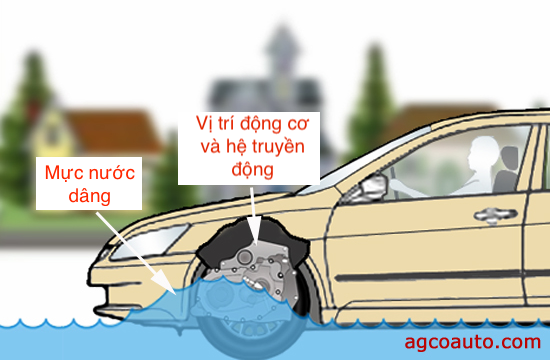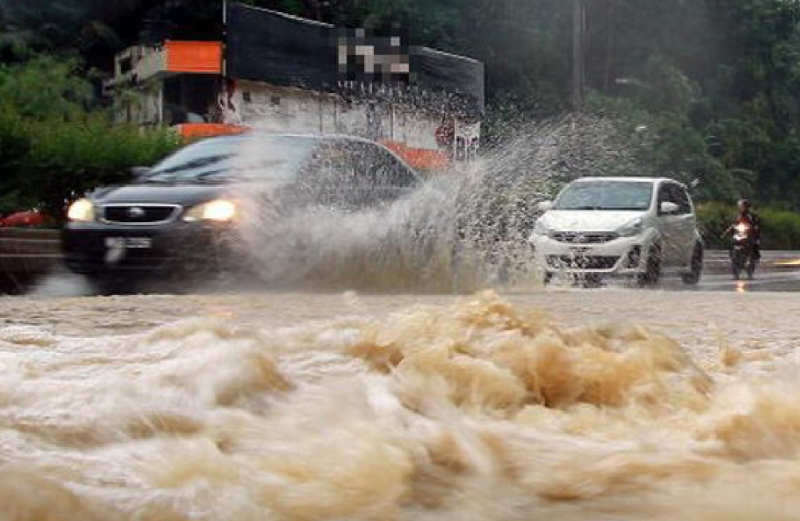Heavy rains often cause water to flow rapidly over roads near mountains or spillways, creating a hazard for vehicles. Here are some safe driving tips for drivers who are forced to travel through these areas.

Recently, social networks shared a video from a security camera showing a low-slung sedan trying to pass through a flooded and fast-flowing road, resulting in the car being swept away by the water. This is an extremely dangerous situation that drivers have to face during the current rainy and flooded days when traveling through roads in the northern mountainous areas (such as in Tuyen Quang, Lao Cai, Yen Bai...).
The sensible choice in extreme weather is to stay safe and high. But what if you’re driving when a storm hits or find your path blocked by a flooded road? When is it safe to continue driving and when should you turn around?
Below are some tips for drivers to drive safely when encountering situations where they have to go through flooded and fast-flowing roads.
1. Take a different route
Never drive through deep, fast-flowing water, especially low-chassis vehicles such as sedans and hatchbacks. If you encounter this situation on the road, if you have the option of taking a different route or a detour, do not regret the fuel cost or the extra time. The cost of this option will still be cheaper than the safety for yourself and your vehicle.
You can use navigation software or ask locals to find suitable alternative routes.
2. Check the water depth
If you have no other choice and decide to cross a section of fast-flowing water ahead, it is important to check the depth of the water.
If you have a pair of rubber boots, it is a good idea to step down to check the water level and flow rate. In the dark, you will need a flashlight to see clearly or drive closer to take advantage of the headlights. In case you cannot go down to the water, you can observe the cars, trucks passing by to estimate the water level.
Unless you’re driving a 4x4 or an off-road capable SUV, the maximum depth most experts recommend driving through is 100mm. Modern low-riding vehicles are often so well-sealed that they can start to float like a boat in water as little as 300mm deep, which when combined with fast-moving water can be very dangerous.
3. Open the window
According to experts, opening the window parallel to the direction of water flow will help the driver and passengers in the car to actively escape in case of an accident instead of having to try to break the window, which will take more time.
4. Let oncoming vehicles pass first.
When preparing to cross a flooded area or an area with fast-flowing water, you should wait for oncoming vehicles to pass first, especially high-chassis or large vehicles because when they pass, they can create large waves that can knock smaller vehicles off course or cause water to flood into the engine compartment and cause damage.
5. Driving in the middle of the road
Most flooded roads and fast-flowing water make it difficult to see the terrain below. Therefore, to avoid driving on the edge of the road or into a sinkhole, it is best for drivers to move to the middle of the road and observe surrounding details such as trees, stakes, and rocks to gauge distances.
6. Don't drive too fast
Driving through flooded areas should be done slowly, around 5km/h is appropriate, with a steady throttle. If you drive too fast, not only will you create a wave of water that will spray other road users, but you also risk losing contact with the road surface with your tires. If this happens, do not brake, just take your foot off the accelerator and keep the steering wheel straight and wait for traction to return.

7. Don't stop
Although drivers should drive slowly, it is important not to stop the vehicle when crossing deep water as this can cause water to enter the exhaust pipe, travel back up to the engine and cause costly damage.
The driver needs to keep the engine at a steady speed. If it is a manual transmission, the speed can be controlled by using the clutch, but if it is an automatic transmission, select the lowest possible gear and keep your foot firmly on the pedal.
8. Dry the brakes after riding.
After passing through flooded areas, what you need to do is continue moving while applying the brakes a few times to quickly dry the brake pads, ensuring effective operation on the road.
If the worst happens and your car is stuck in deep water, stay inside and call for help. Don’t get out or try to open the hood, as you could make things worse. If your car stalls, don’t try to restart the engine as this could force water into the car and cause hydrolocking.
TH (according to Vietnamnet)